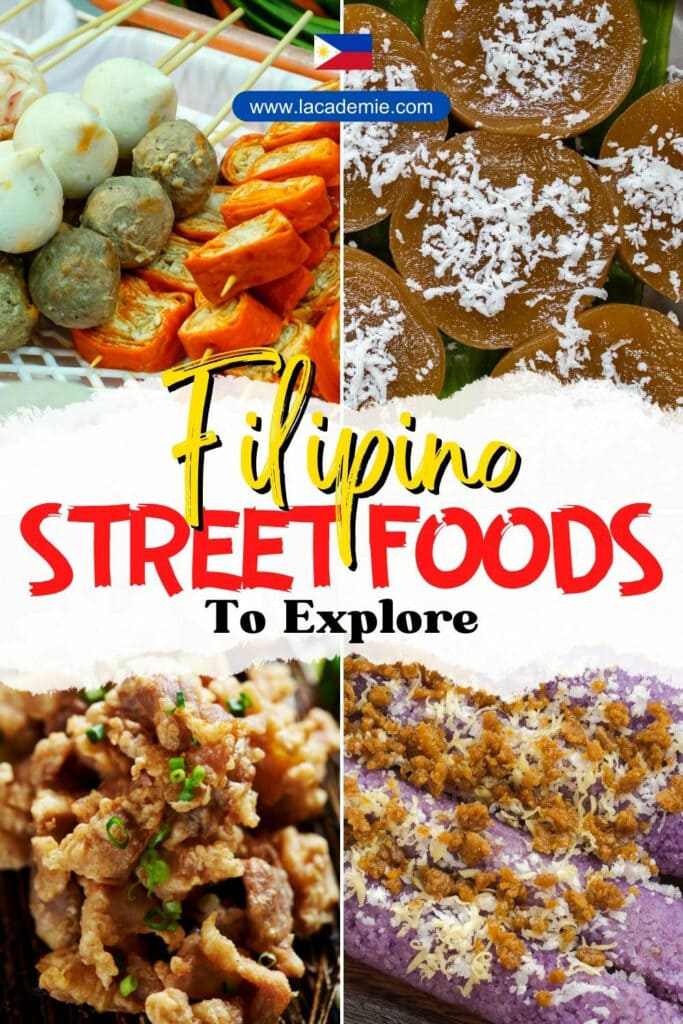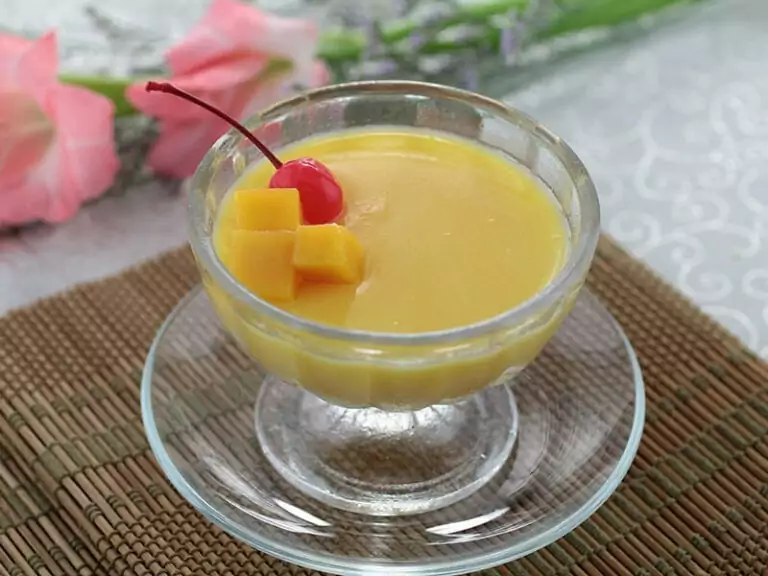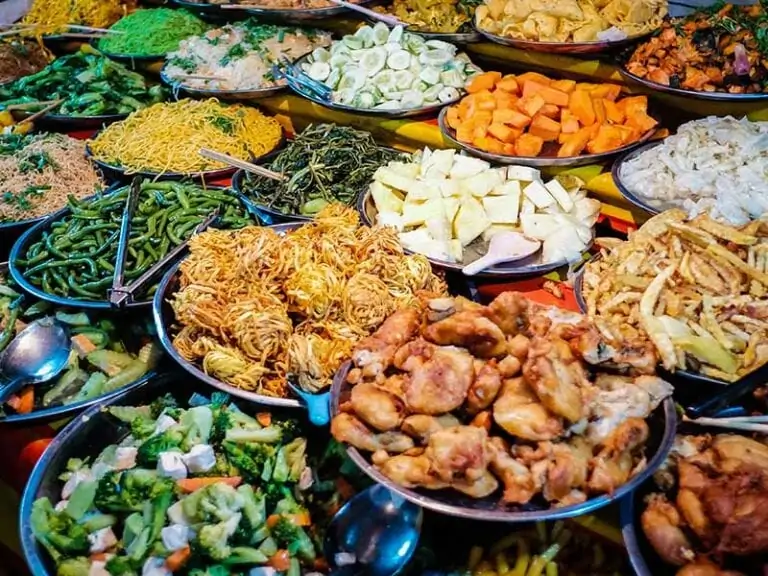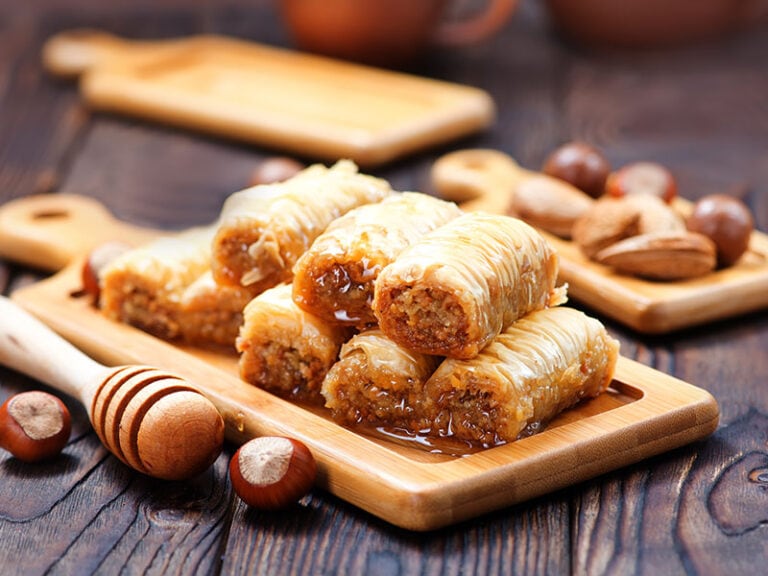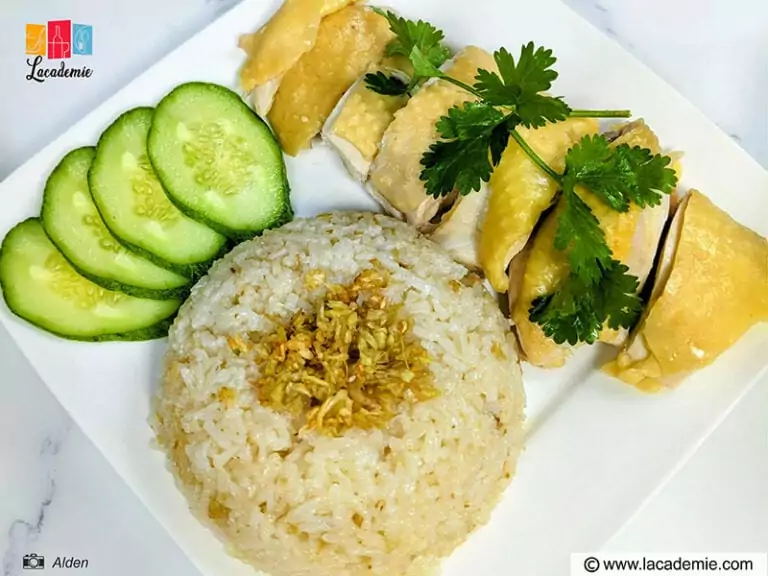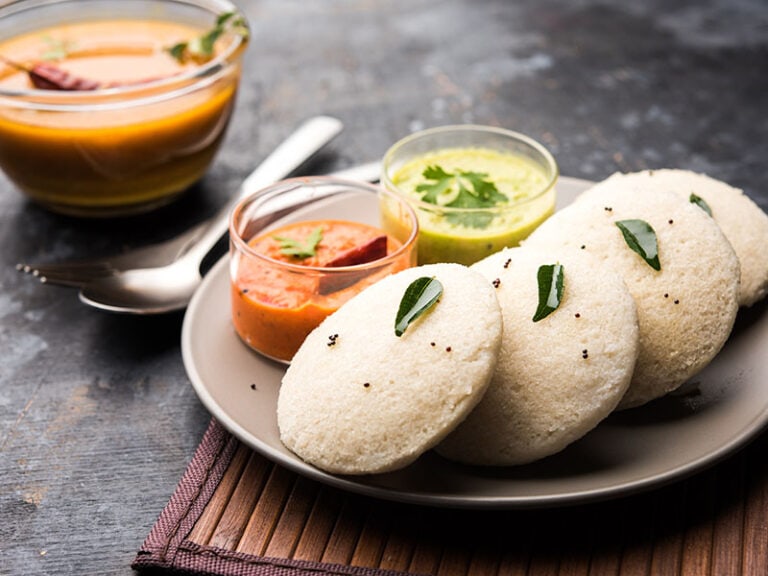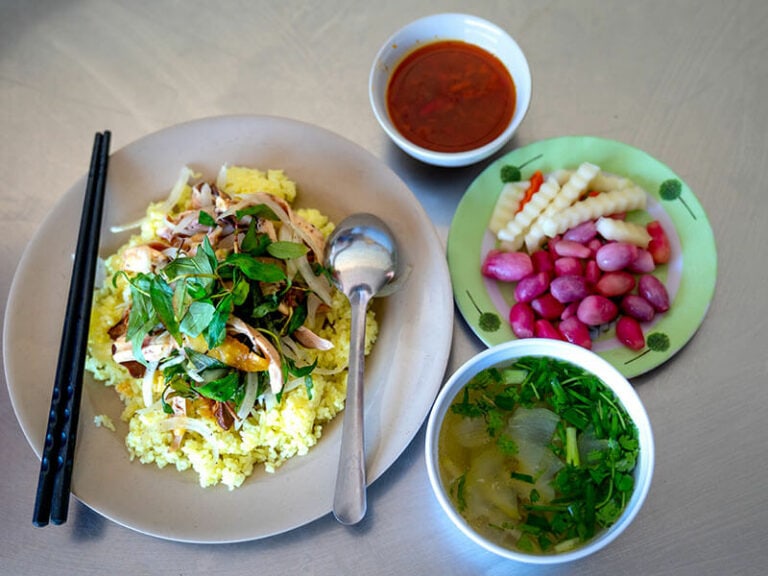Curious about the most well-known and well-loved Filipino street foods? Of course, you would! When you visit a new country, eating street foods is the easiest way to learn more about its cuisine and native culture.
The street snacks from the Philippines are truly iconic. Traditional Filipino dishes has their own unique aspect that you can hardly find in the cuisine of other countries. So if you’re ready to learn everything you need to know about these delicacies, let’s get started!
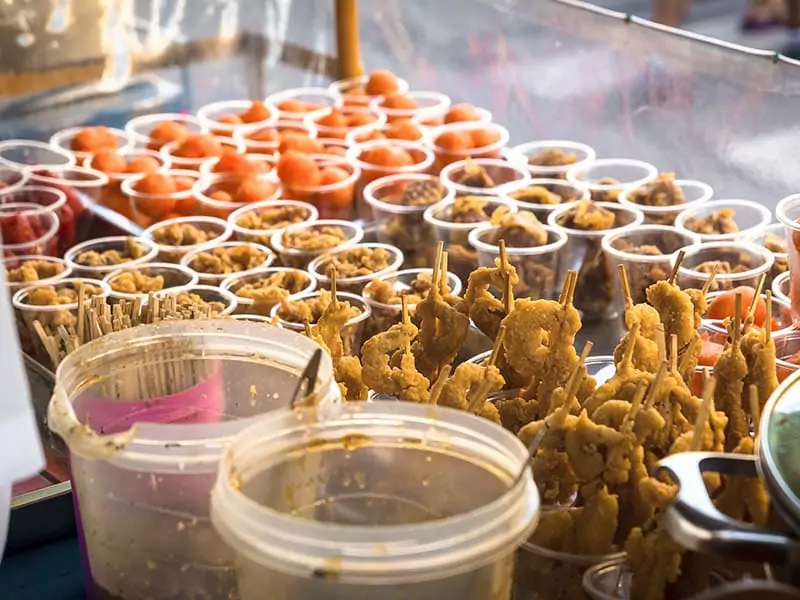
13 Yummy Fried Dishes That You Can Find At Filipino Street Vendors
It is safe to say that Filipinos are a fan of deep-fried foods. Just look at this massive list of fried snacks; isn’t that amazing! These guilty pleasures might not be the healthiest, but they are so tasty that you won’t be able to control your craving.
1. Lumpiang Shanghai – Filipino Spring Rolls
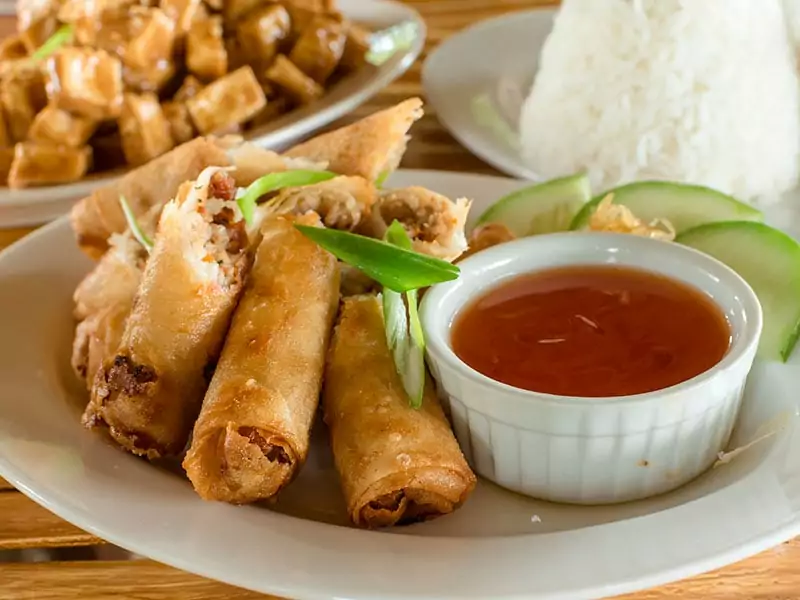
Lumpiang Shanghai is a culinary hit in every Filipino family gathering for a reason. This crunchy deep-fried treat is not only fun to prepare but also fun to eat.
Spring rolls are a classic meal for special and celebratory occasions, but they are also offered at various street booths around the country. These tasty rolls usually come with sweet and sour dipping sauce.
Lumpiang Shanghai, derived from a specialty in many Chinese meals, is the most well-known Lumpia (spring rolls) variant in the Philippines. This version differs from others by its savory filling made of ground pig or beef, carrots, onions, and (sometimes) shrimp.
Recommended places to eat:
Address: 432, 1004 San Andres St, Malate, Manila, 1004 Metro Manila, Philippines
Time: Open 24/7
Phone: +63285247671 to 75
Website: aristocratph.com
Facebook: www.facebook.com/
Instagram: @aristocrat_ph
Price: 358PHP (~7USD) per portion
Address: Otek St, Baguio, Benguet, Philippines
Time: Open 24/7
Phone: +639191234567
Facebook: m.facebook.com/
Price: 120PHP (~2.3USD) for a combo with rice
Address: 21 Mayor Gil Fernando Ave, Marikina, 1801 Metro Manila, Philippines
Time: 10AM–2:30PM, 5–9:30PM
Phone: +639952604573
Facebook: www.facebook.com/
Price: 260PHP (~5USD) per portion
2. Kwek Kwek – Fried Orange Quail Eggs
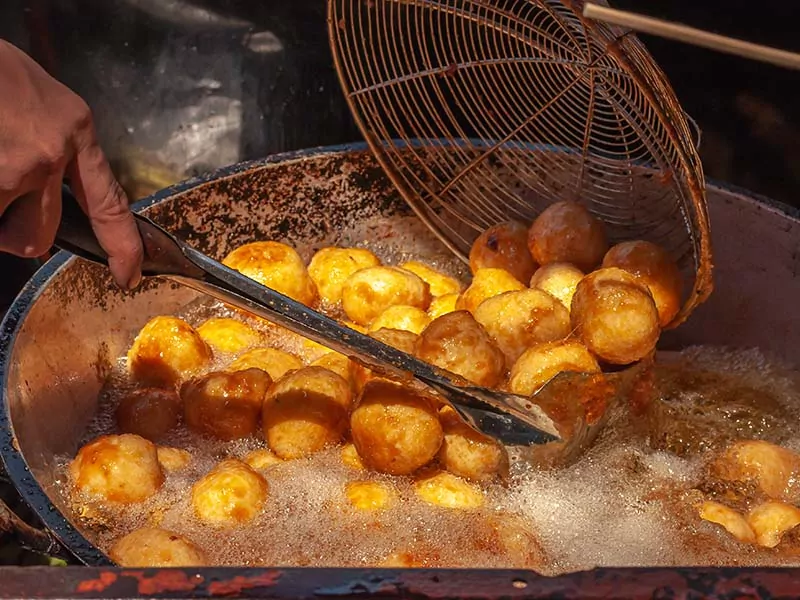
These little orange quailed eggs are truly irresistible. The crispy texture of the fried quailed eggs combines with the unique flavor of its signature sauce to create a delicious street snack that can make both children and adults drool.
To give Kwek Kwek its orange hue, the locals make a batter out of flour, water, cornstarch, and annatto powder (an orange-red food coloring). Then they will dip the boiled quail eggs in it, fry them well, and serve with hot and sour sauce.
Here’s a fun fact about this dish: Kwek Kwek invention was totally accidental. Long ago, there was a Balut (fertilized duck eggs) seller in Cubao who dropped her products. She then took off the shells, wrapped the eggs in flour, and deep-fried them, not wanting to waste the Balut.
This dish became a huge hit, and it continues to spread its popularity. Funny how some of the most iconic dishes in the world were discovered by pure accident like this one.
Want to see how the local vendors prepare Kwek Kwek? Take a look!
Recommended place to eat:
Address: 10 A. Mabini St, Malate, Manila, 1004 Metro Manila, Philippines
Time: 10AM–8PM
Price: 30PHP (~0.5USD) per piece
3. Proben – Fried Chicken Skin
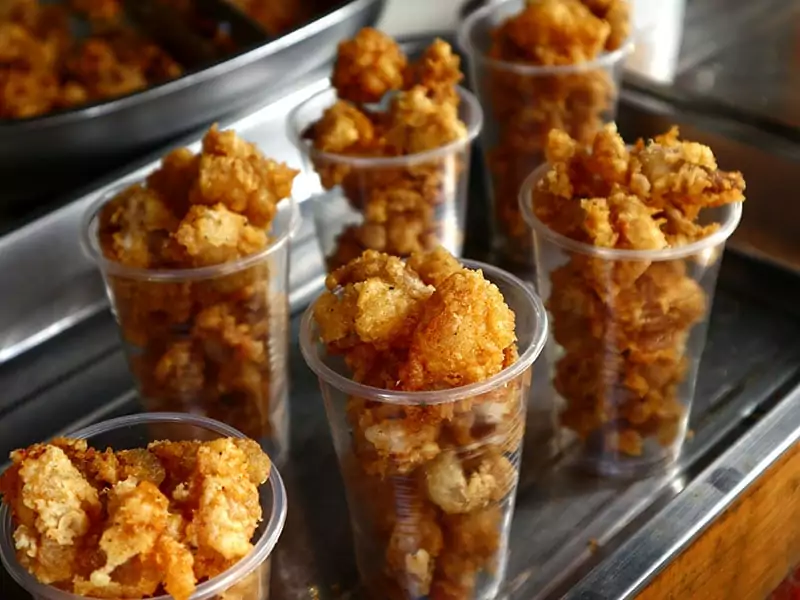
Fried chicken skin is another famous guilty pleasure in the Philippines. As the name suggested, it comprises chicken skin that’s been battered and deep-fried till golden brown and crispy, and that’s it!
This Philippines street snack is a favorite among students and people on a budget since chicken skin is both filling and inexpensive! Although this dish is relatively high in cholesterol and fat (it’s a “guilty” pleasure, after all), no one can deny how addicting it is.
If you’re looking for a more substantial supper on a budget, get rice at the nearby eatery and couple it with the chicken skin.
Recommended place to eat:
Address: Gen. Luna St, Sangandaan, Caloocan, 1400 Metro Manila, Philippines
Time: 2–8PM
Phone: +639228880842
Facebook: www.facebook.com/
4. Fish Balls
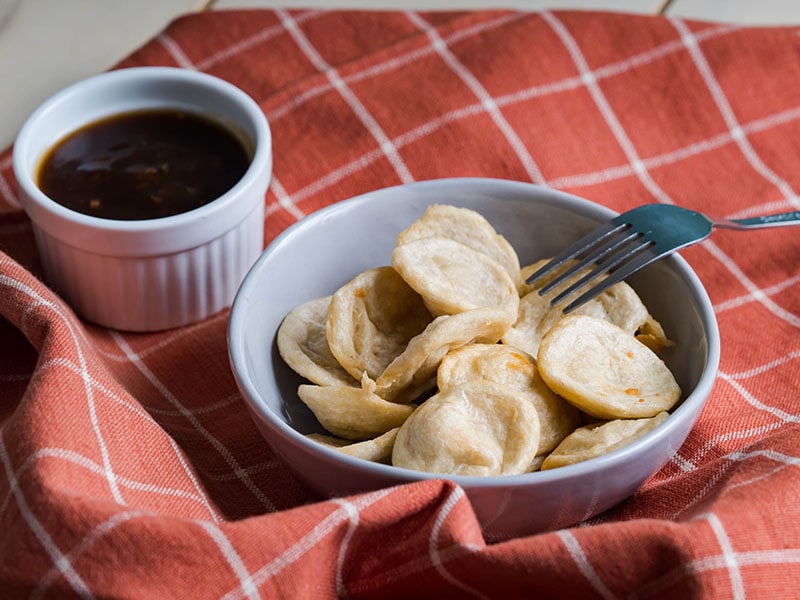
Fish balls are an affordable yet satisfying snack in the Philippines. In fact, it is the cheapest dish here. The Filipinos even coined the phrase “fish balls na lang ang hindi nagmamahal”, referring to how the fish balls are the only dish that stays cheap when everything else becomes pricier.
The vendors make their delicious fish balls from flattened and skewered groundfish (often pollock or cuttlefish). While walking on the streets of Metro Manila, you will often catch sights of vendors pushing their wooden carts, selling this seafood treat.
Recommended place to eat:
Address: A street cart outside of Saint Jude Catholic School – 328 Ycaza St., San Miguel, Manila (next to Malacañang Palace)
TIme: 7AM–4PM (Close on Thursday and Sunday)
Phone: +639184459449 or +639083976679
Facebook: www.facebook.com/
5. Squid Balls
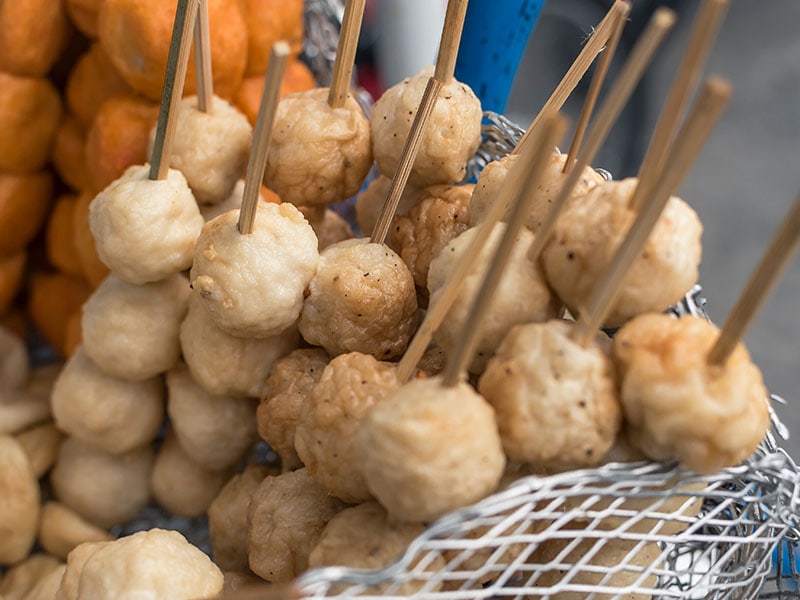
Squid balls in the Philippines are similar to fish balls. However, they are round, fluffy and do not get limp when cooked. They are also one of the Philippines’ most well-known and well-loved street delicacies.
These flavorful squid balls are made from squid (of course), garlic, flour, and cornstarch. The vendors usually pre-shape them before frying. Then, they will serve them on skewers with Manong’s thick brown sauce or seasoned vinegar dipping sauce.
Recommended place to eat:
Address: 2/F Uptown Place Mall, 36th St. Cor. 9th Ave., Bonifacio Global City, Taguig, Metro Manila, Philippines
Time: 11AM-10PM on Monday-Thursday, 11AM-12AM on Friday, 10AM- 12AM on Saturday, 10AM-10PM on Sunday
Phone: 0288025596 or 09778340094
Website: corazon.ph
Facebook: www.facebook.com/
Price: 295PHP (~0.5USD) for a portion of fish and squid balls
6. Kikiam – Fried Sausage-Like Dish
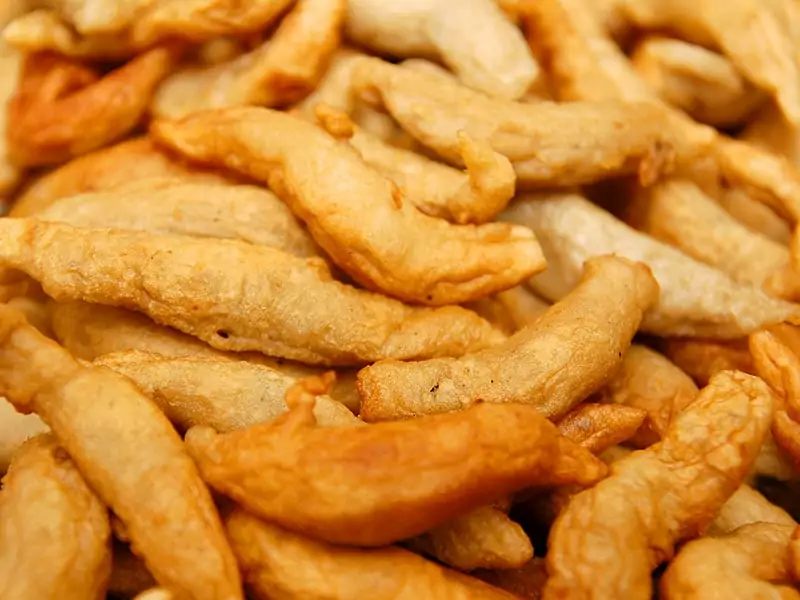
Kikiam is a Filipino variation of Ngo Hiang – a popular Chinese street food that contains seasoned minced pork and veggies rolled inside a beancurd skin.
Since its introduction in the Philippines, it has been quickly adopted. In fact, Kikiam has been used in a variety of Filipino dishes.
Unlike the Ngo Hiang, the Kikiam usually contains fish and a lot of fillers. It is like an elongated version of fish balls rather than the original deep-fried Chinese dish. However, the street food version of Kikiam does have pork and five-spice powder, just like the Chinese version.
Here is how the Filipinos serve and eat Kikiam!
Recommended place to eat:
Address: 519 Quintin Paredes Rd, Binondo, Manila, 1006 Metro Manila, Philippines
Time: 9AM–9PM
Phone: +63282419991
Facebook: www.facebook.com/
Instagram: @earlynightph
Price: 50PHP (~1USD) per portion
7. Chicharon Bulaklak – Deep-Fried Pork Intestine
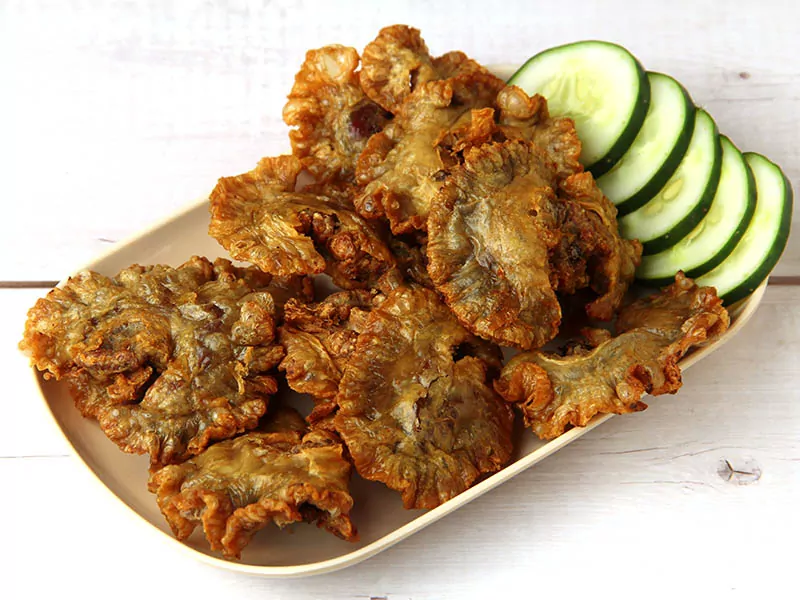
Intestines might not be a typical dish in Western countries, so this dish might sound intimidating at first. But please, just try it once, it will change your mind! You might have some difficulties finding it on the streets but you can definitely find this tasty Filipino pork dish in bars.
Bulaklak is made of crunchy, savory deep-fried pork chitterlings or mesentery. The name of this dish actually means “‘flowers”, which is a fitting description since the intestines will coil up into flower-shaped crisps when they are fried.
This top-notch street food is also a typical Asian appetizer or beer food. When you set your foot in the Philippines, you can easily find small Bulaklak stands on the sidewalks, selling this snack and other chicharron dishes.
Recommended place to eat:
Address: By Pass Road, San Vicente 2, Silang, 4118 Cavite, Philippines
Time: 10AM–5PM
Phone: +639277922600
Facebook: www.facebook.com/
Price: 350PHP (~6.8USD) per portion
8. Empanada – Deep-Fried Meat Pastries
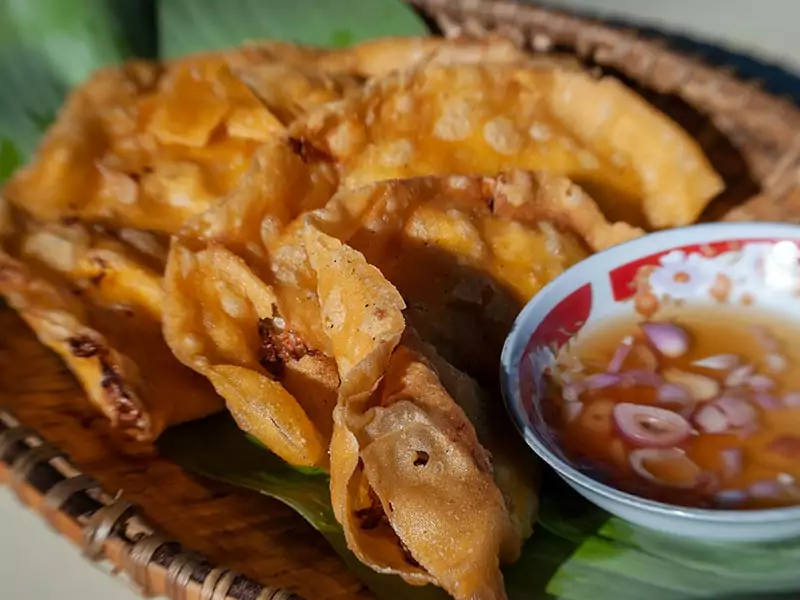
By looking at this dish, you can quickly see how exquisite Spanish cuisine influences the Philipines. Empanada is a cheap and filling pastry. Depending on the location, this pastry is typically loaded with ground meat and different veggies.
This dish is incredibly popular in Vigan, home to many renowned forms of Filipino Empanada. Vigan Empanadas usually have Vigan sausage, green papaya, mung bean sprouts, and a whole egg.
Nowadays, many food park vendors and small restaurant chains specialize in Vigan Empanadas. So you don’t need to travel all the way to Vigan to taste this unique variance of Empanada.
Recommended places to eat:
Address: 101 1230, Campos Rueda Bldg, Urban Ave, Makati, Metro Manila, Philippines
Time: 7AM–10PM (Sunday: 2–10PM)
Phone: +63289845282 or +63289845202
Website: order.empanadanation.ph
Facebook: www.facebook.com/
Price: 60PHP (~1.2USD) per portion
Address: FRDC Building, 106 Eulogio Rodriguez Jr. Ave, Pasig, Metro Manila, Philippines
Time: 9AM–9PM
Phone: +639998850092 or +63285711541
Website: momandtinas.com/
Price: 55PHP (~1.1USD) per portion
9. Ukoy/ Okoy – Shrimp Fritter
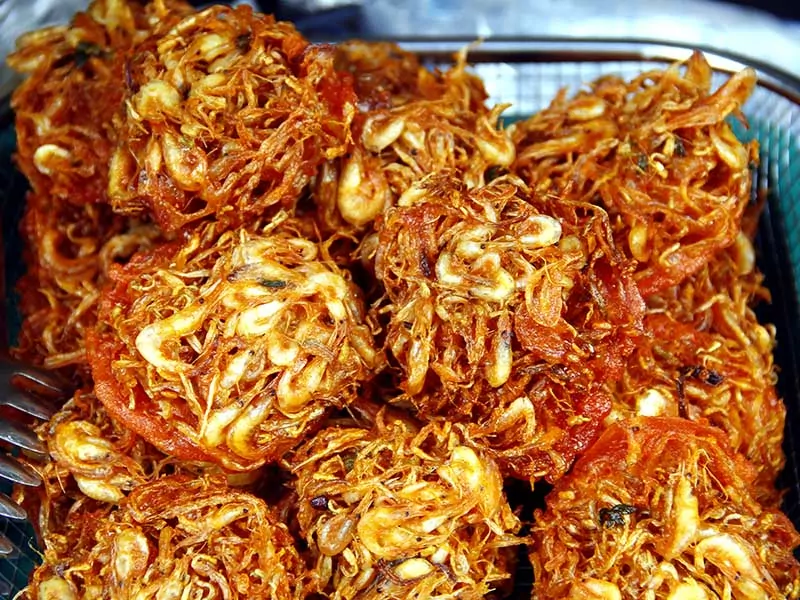
Filipino shrimp fritters, also known as Ukoy or Okoy, are created with tiny shrimp that are battered and deep-fried with the head and shell still on.
This Asian shrimp delight usually comes with a spicy vinegar sauce to balance the oiliness; however, some prefer ketchup, garlic mayonnaise, or sweet and sour sauce. Ukoy tastes fantastic on its own as a snack, appetizer, or breakfast item, but you can pair it with rice to make it a filling meal.
Like Empanada, this dish’s most well-known regional variation is in Vigan. Vigan Ukoy contains spring onions and glutinous rice flour, making the fritter taste much better than those with only shrimps.
There are several variants available that include veggies such as mung bean sprouts and julienned zucchini in other Philippines regions.
Recommended place to eat:
Address: Bldg 27, GF Barrington Place, 31 Congressional Ave, Quezon City, 1106 Metro Manila, Philippines
Time: 11AM–5PM (Close on Sunday)
Phone: +639171506569
Website: okey-na-okoy.business.site
Price: 40PHP (~0.7USD) per portion
10. One Day Old – Fried Baby Chicken
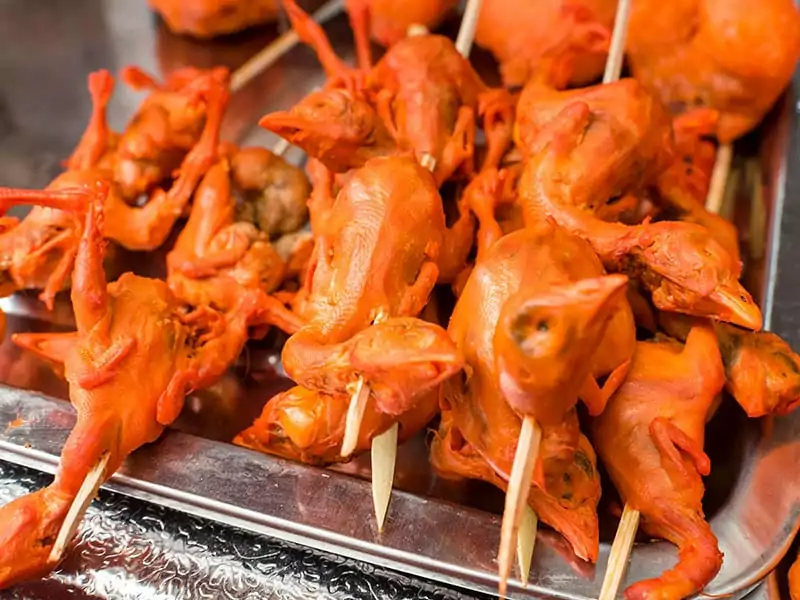
Take a deep breath before I explain this dish to you. This dish contains a whole deep-fried one-day-old chick; most locals pair it with diced cucumber and vinegar or sweet chili sauce.
The fried chick can be eaten off a skewer with its bone and beak since they are still soft. And it is so small that you can eat the whole chicken in just a few bites, starting with its head.
Yes, this dish does seem kind of intimidating to most. After all, it is one of the most adventurous street food nibbles in the Philipines.
However, these one-day-old birds are frequently rejected by poultry farms because they are useless in egg production. Instead of being tossed away, the chickens are turned into an everyday treat. So, in the end, this dish is beneficial not only for the people but also for the economy.
Curious about what One Day Old tastes like? This can help you out!
Recommended place to eat:
Street vendors throughout Filipino markets
Price: 10PHP (~0.20USD) per skewer.
11. Cascaron/ Bitsu-Bitsu – Filipino Doughnut
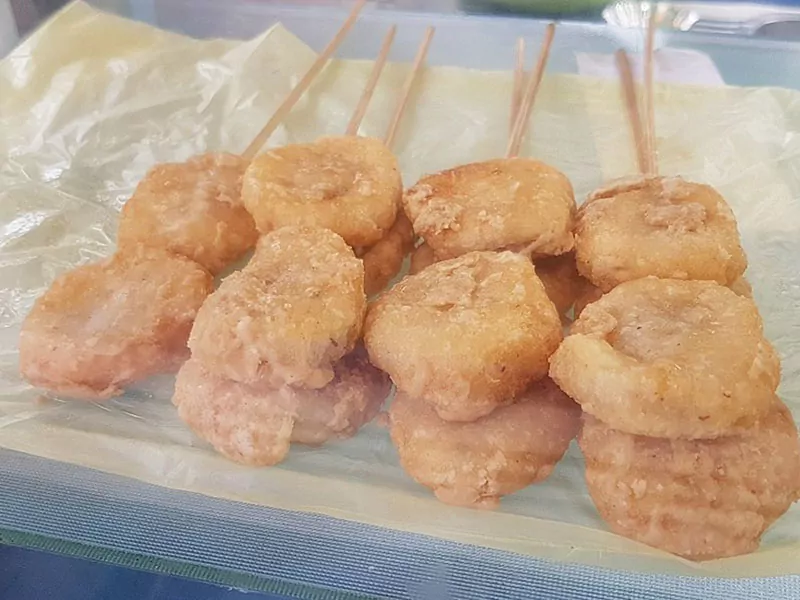
Here’s another deep-fried Filipino delicacy, but this time, it is sweet! These round, sweet, and chewy doughnuts are called Cascaron or Bitsu-Bitsu.
These unique treats are made of glutinous rice flour, coconut milk, shaved coconut, and generously bathed in sugar syrups like caramel sauce or Filipino Latik.
Cascaron are usually shaped into balls and sold on skewers. However, some vendors will shape the dough into rings, pancakes, or rectangles.
This traditional confection is crispy on the outside but still soft on the inside, making it the perfect treat for sweet lovers.
Recommended place to eat:
Street vendors throughout Filipino markets
12. Banana Cue/ Banana Q – Caramelized Banana
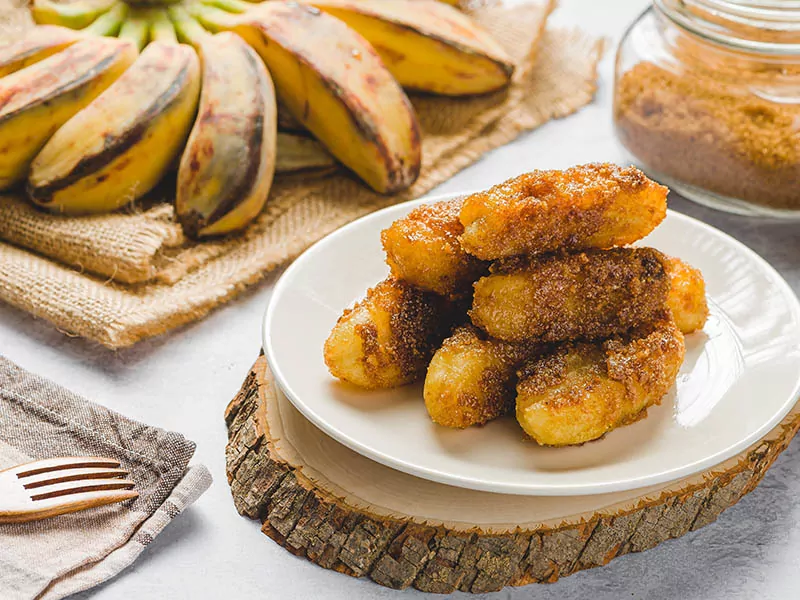
When it comes to notable Asian dishes, tourists can easily find tropical fruits incorporated in creative ways. That is why fruits, especially bananas, play a crucial part in the Filipinos’ diet.
Banana Cue is a fun treat made by deep-frying skewered bananas and coating them in a caramel sauce made from brown sugar. The name of this dish is a fun play of words that stems from the English noun “barbecue”. It can also be shortened to “Banana Q”.
Although this sweet food snack is very simple, it is iconic to this island country. The Filipino vendors usually sell this dish along with Camote Cue, which is caramelized sweet potato.
If you’re a banana fan, this Banana Cue stand will make your mouth water!
Recommended place to eat:
Address: Stall 29 B. Morcilla St, Makati, 1217 Metro Manila, Philippines
Phone: +639279489709
Price: 50PHP (~1USD) per portion
13. Turon – Banana Lumpia with Caramel
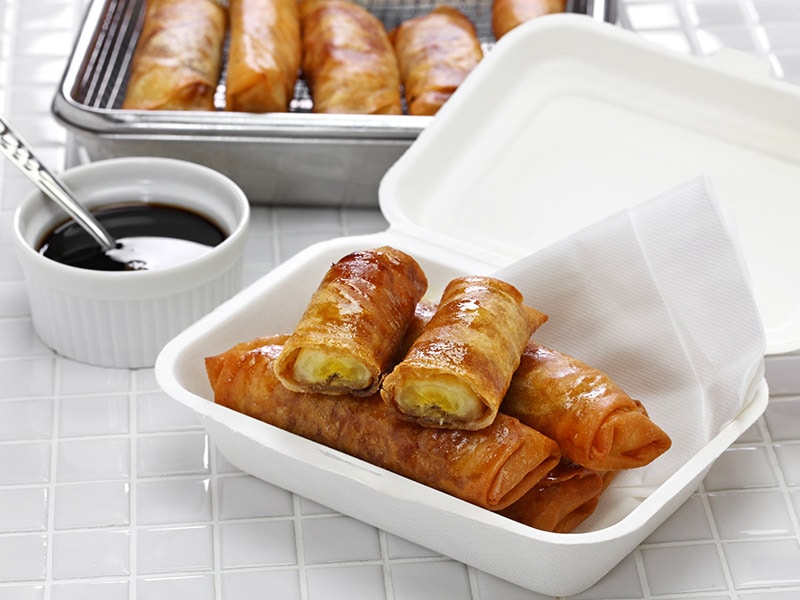
Since Lumpia is extremely popular in Filipino cuisine, Turon, the sweet Lumpia made with banana and caramel filling, has that same status quo in the world of Filipino desserts.
Similar to any other Lumpia, Turon contains a spring roll wrapper. The difference here is that this version of Lumpia uses banana, the famous tropical fruit in the Philippines and other Asian countries.
After deep frying, the snack is coated with caramelized brown sugar to make it extra sweet and mouthwatering. The perfect combination of crispy texture and sweet flavor of Turon can definitely make your day.
This tasty treat is always available on the streets of the Philippines. But to locals, this is something they can easily recreate at home.
Recommended place to eat:
Address: 1135, 1008 Padre Noval St, Sampaloc, Manila, 1008 Metro Manila, Philippines
Time: 10AM–5PM (Close on Sunday)
Phone: +63284044561
Facebook: www.facebook.com/
Instagram: @mangtootzfoodhouse
Price: 75PHP (~1.5USD) for 15 pieces
Try Out These Tasty Grilled Treats In The Philippines
If you take a stroll on the streets of the Philippines in the middle to late afternoon, you will catch the scent of charcoal being lit. That is when you know it’s time for an afternoon grilled or roasted snack. Here are some suggestions.
14. Tocino – Filipino Grilled Cured Pork
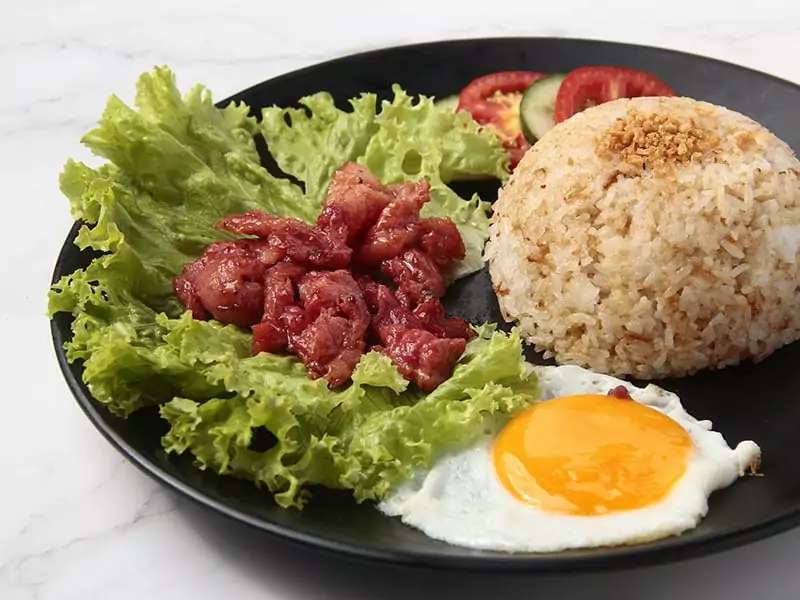
Just like Empanada, Tocino is also a typical Spanish meat dish. This delicious street food consists of thin strips of pork belly that have been cured for 3 days with annatto, anise wine, sugar, and salt.
In some cases, the locals will marinate the meat strips with pineapple juice to add a slight tart flavor to the pork.
This flavorful dish can be found from street vendors, but it is also available in local restaurants. Tocino is frequently served as a breakfast or lunch item along with rice and a sunny-side-up egg. It also comes with various Filipino sauces that you can pick from.
Recommended place to eat:
Address: St., Brgy. San Angelo, San Andres St, Angeles, Pampanga, Philippines
Time: 8AM–8PM
Phone: +639753629167
Facebook: www.facebook.com/
Price: 280PHP (~5.5USD) per portion
15. Isaw – Grilled Intestine
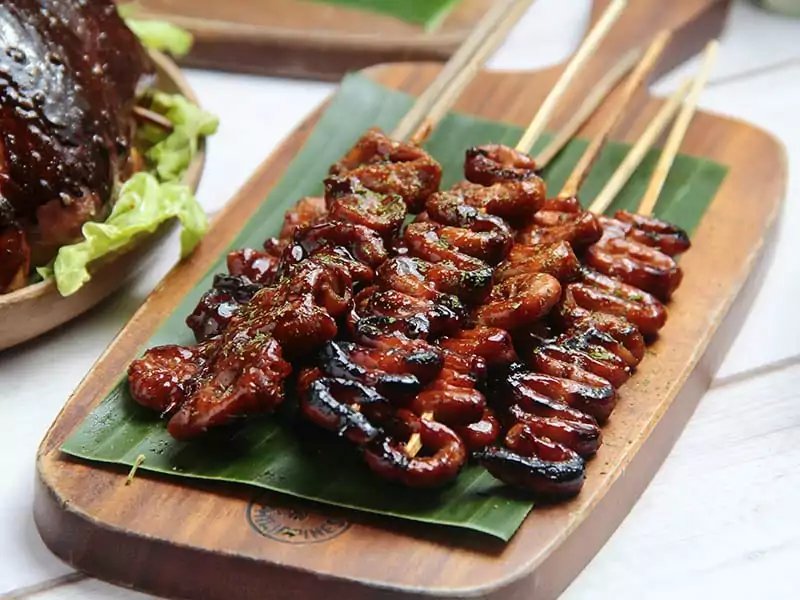
If you enjoy Bulaklak, the deep-fried pork intestines I mentioned in the last section, you will love this dish! Isaw is a Filipino street food made of marinated, boiled, and grilled intestines.
Back story time: During the 1970s, Filipino street vendors started selling lots of scraps of pork and chicken, including the intestines. This is because the locals could hardly afford expensive cuts of meat due to the economic crisis. And that was when Isaw gained its popularity.
The intestines used for Isaw can either be from a pig or chicken. Pork Isaw is often significantly bigger and chewier than chicken Isaw, despite their similarities in cooking methods.
According to the locals, the best thing about eating Isaw is its chilly vinegar dip. The smoky grilled intestines and the vinegar creates a delightful contrast that can make you drool, especially when paired with liquor or beer. It also goes great with a bowl of hot rice.
Check out this Isaw street vendor in the Philippines and learn more about this dish!
Recommended places to eat:
Address: 109 Rada, Legazpi Village, Makati, Metro Manila, Philippines
Time: 11AM–8PM
Phone: +639175280115
Facebook: www.facebook.com/
Instagram: @sarsakitchen
Price: 350PHP (~6.8USD) for 6 sticks
Address: C3, 7th Ave corner 30th Street Bonifacio High Street Central, Taguig, Metro Manila, Philippines
Time: 11AM–9PM
Phone: +639178917053
Website: www.raintreehospitality.net/
Facebook: www.facebook.com/
Instagram: @friendsandfamilyph
Price: 55PHP (~1.1USD) for a stick of chicken Isaw and 65PHP (~1.3USD) for a stick of pork Isaw
Address: E. Jacinto Street, Diliman, Quezon City, Metro Manila, Philippines
Time: 10AM–9PM
Phone: +639212347389
Facebook: www.facebook.com/
16. Betamax – Grilled Blood
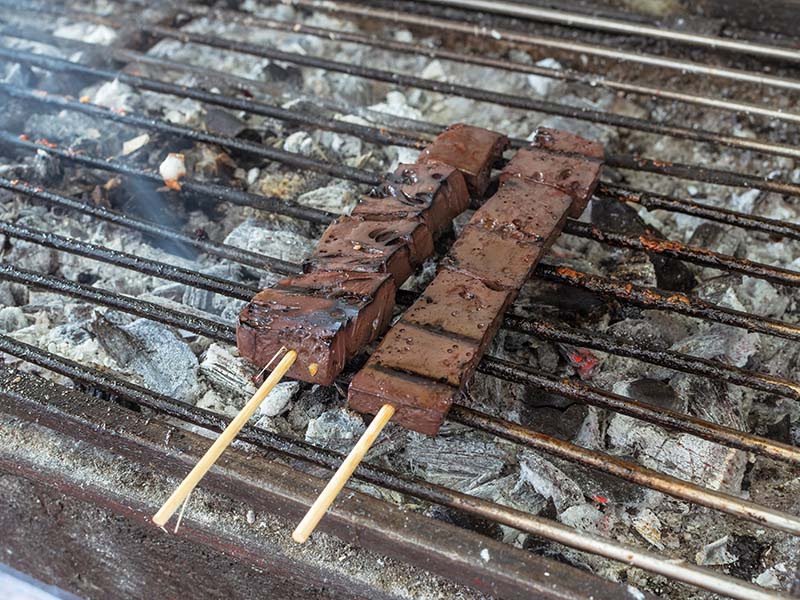
When people hear the word “Betamax”, they will usually think about the Betamax video cassette tape. However, this is also the name of a unique grilled street snack in the Philippines.
It consists of coagulated pig or chicken blood. The blood cubes are formed into squares just like the shape of the old cassette tape, which is how the dish got the name Betamax.
Betamax has no unpleasant odor or taste, despite the fact that it is made from blood. However, the taste of this dish is pretty mild, almost bland even. But it will taste amazing once coated in a hot vinegar sauce.
Recommended place to eat:
Address: C3, 7th Ave corner 30th Street Bonifacio High Street Central, Taguig, Metro Manila, Philippines
Time: 11AM–9PM
Phone: +639178917053
Website: www.raintreehospitality.net/
Facebook: www.facebook.com/
Instagram: @friendsandfamilyph
Price: 55PHP (~1.1USD) for a stick
Address: 640 San Rafael St, Mandaluyong, 1550 Metro Manila, Philippines
Time: 4PM–11PM
Phone: +639177015506
Website: gotobelieveph.com
Facebook: www.facebook.com/
Instagram: @gotobelieveph
Price: 55PHP (~1.1USD) per portion
17. Pork BBQ
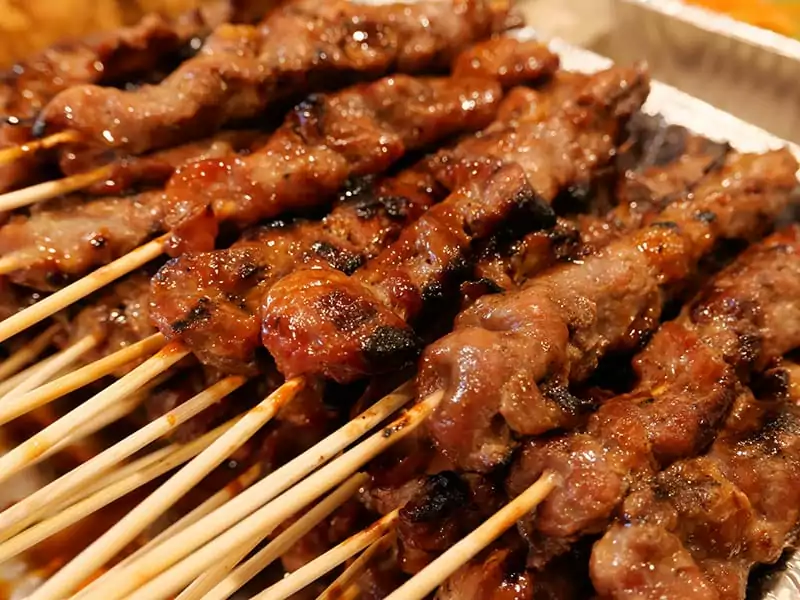
Who can say no to Pork BBQ? This iconic dish contains skewered pork that has been marinated and cooked over coals. It can be served as a side dish with rice and a delicious Filipino appetizer with beer.
These delicious meat skewers are smoky, savory, slightly sweet, and charred in spots, resulting in crunchy black chunks that many people enjoy. There will usually be a small hunk of fat at the end of the skewer, you can eat it if you want, but most people will leave it.
You can find vendors selling this dish on sidewalk stands, but it is also expected at parties, picnics, and workplace celebrations. Besides, it’s especially popular at kids’ parties in the Philippines.
Recommended places to eat:
Address: C3, 7th Ave corner 30th Street Bonifacio High Street Central, Taguig, Metro Manila, Philippines
Time: 11AM–9PM
Phone: +639178917053
Website: www.raintreehospitality.net
Facebook: www.facebook.com/
Instagram: @friendsandfamilyph
Price: 85PHP (~1.7USD) per stick
Address: 1324 Filmore St, Makati, Metro Manila, Philippines
Time: 8AM–9PM
Phone: +63288848888
Website: amber.com.ph
Price: 135PHP (~2.6USD) for 5 pieces
18. Walkman/ Tenga – Grilled Pig Ears
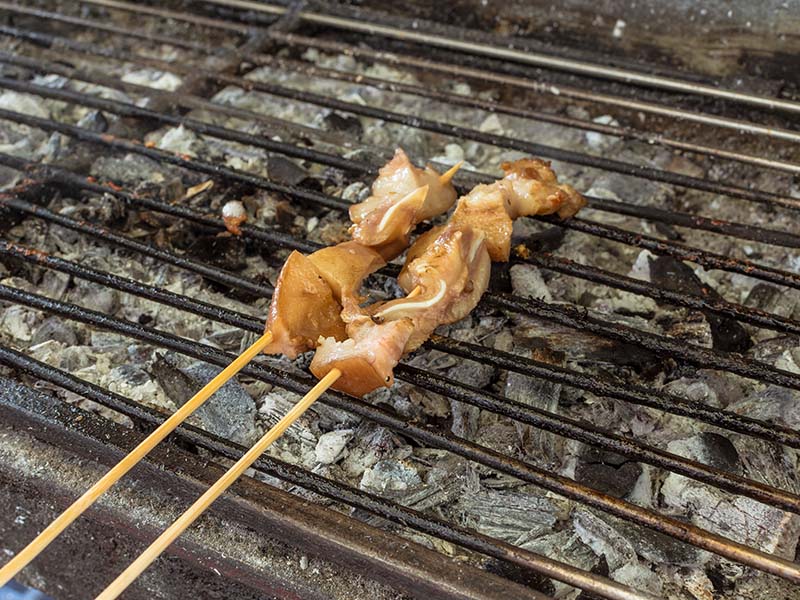
Interesting name, isn’t it? This dish got its name around the early 80s due to the rising popularity of the famous portable-listening gadget Walkman and the pop culture in the Philippines.
Before placing the meat on the grill, the vendors will chop it into bite-sized pieces and marinate it in vinegar and soy sauce. While grilling, the skewered ears are basted in a homemade sweet and sour barbecue sauce every now and then.
These grilled pig ears are marbled with meat, skin, and cartilage, creating a chewy and flavorful snack that you can hardly resist.
Recommended place to eat:
Street vendors throughout Filipino markets
19. Lechon Manok – Grilled Chicken
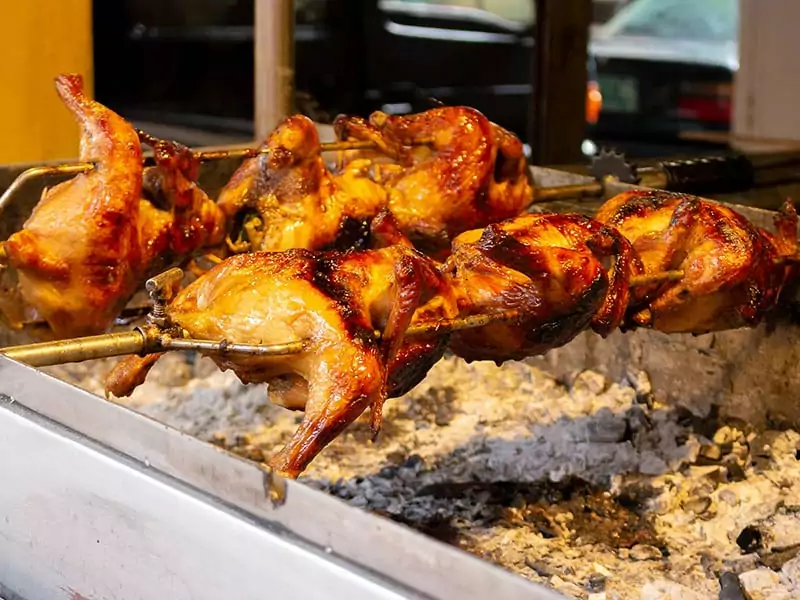
Grilled chicken can be found in pretty much every cuisine worldwide, and Filipino is no exception. Like any other grilled dish in this country, Lechon Manok is prepared and cooked over an open flame to give it a lovely smoky flavor.
This yummy Filipino chicken recipe pairs amazingly well with white rice. This dish has become a classic street food dinner that the working class in the Philippines often enjoy.
Lechon Manok is also a nice snack to go with different beverages in the Philippines. So if you want to go out and grab a cup of beer with your friends, remember to order this dish.
Want to know how the locals cook Lechon Manok? This might help!
Recommended place to eat:
Address: 77 Bravo St, Taguig, 1632 Metro Manila, Philippines
Time: 7AM–10PM (12–10PM on Friday)
Phone: +639772447347
Facebook: www.facebook.com/
Address: Lot 9 Blok 9 Area 3 Luzon Ave, Matandang Balara, Quezon City, 1119 Metro Manila, Philippines
Time: 9AM–2AM
Phone: +639328750036
Website: andoks.com.ph
Facebook: www.facebook.com/
Insragram: @pusongandoks
Price: 259PHP (~5USD) per portion
20. Helmet – Grilled Chicken Head
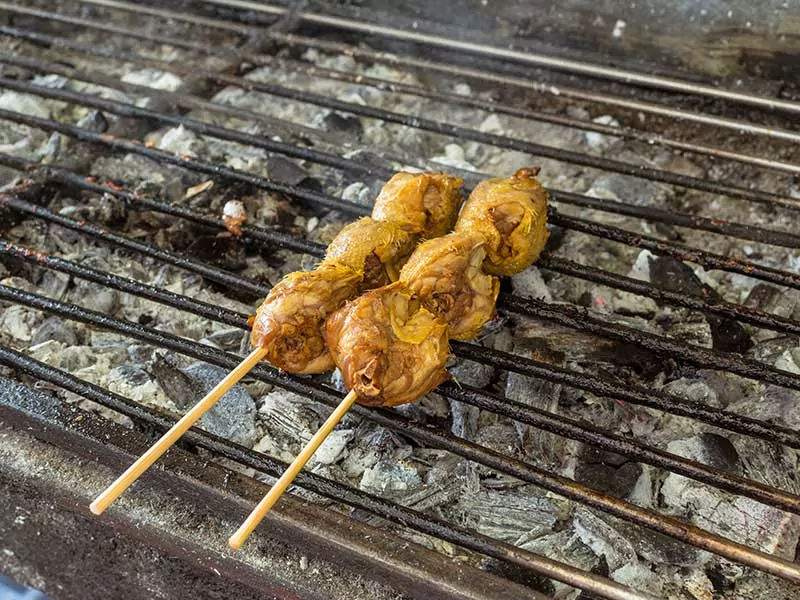
Helmet is another popular chicken dish cooked using charcoal. However, unlike Lechon Manok, this dish only calls for the head of the chicken.
Made out of grilled chicken heads on a skewer, Helmet can be considered one of the more adventurous dishes of Filipino cuisine. I can easily imagine the Filipinos challenging their foreign friends to try the dish just for the pure joy of seeing the horror in their faces.
This dish might be a bit intimidating to foreigners, but it is without a doubt a local favorite. With the right seasoning, these chicken heads can become a fantastic snack, especially when it comes with a few bottles of cold beer.
After eating the meat and skin, some people will break open the chicken head and suck the brain and entrails out.
Recommended place to eat:
Street vendors throughout Filipino markets
Price: 5PHP (~ $0.10USD) per skewer
21. Adidas – Grilled Chicken Feet
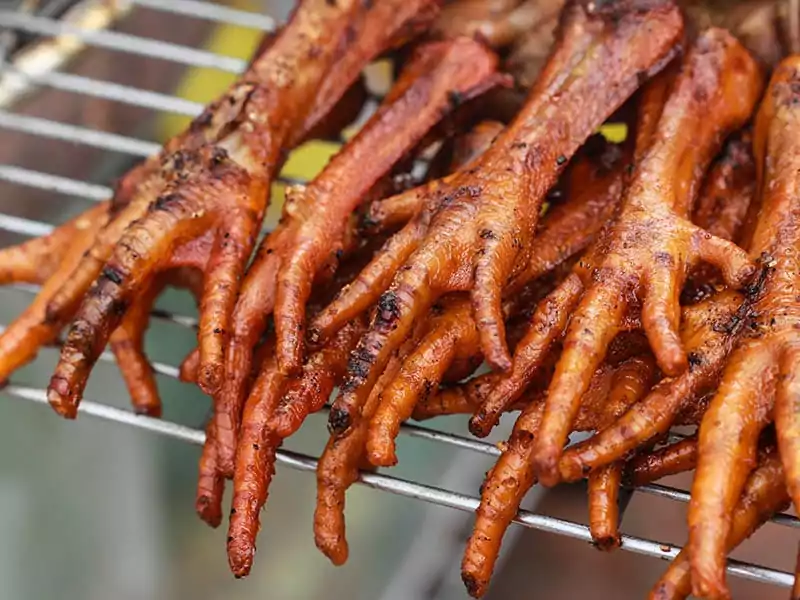
Often found in the same vendors that sell Helmet, Adidas is another funny name given to grilled chicken by Filipinos. The reason for this playful nickname might be because the chicken feet have 3 toes, similar to the 3 stripes logo of the sportswear brand Adidas.
Adidas is one of the most delectable Asian-style street snacks, and it is incredibly famous with beer drinkers all over the islands as the salty and smoky taste complements the beer.
Many Filipinos consider it a tradition to hang out with their friends and grab a few beers while munching on this tasty treat.
Recommended place to eat:
Street vendors throughout Filipino markets
Price: 5PHP (~ $0.10USD) per skewer
3 Notable Boiled Dishes In The Philippines That You Can’t Ignore
After stuffing your belly with fried or grilled foods all day, you might want to take it easy and enjoy something boiled. Here are some of the most recommended ones; enjoy!
22. Balut – Fertilized Duck Egg
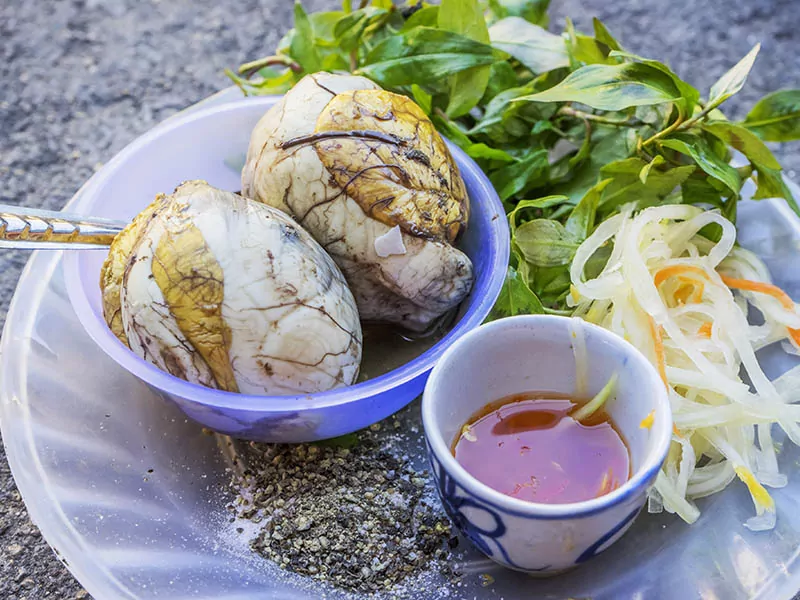
Here’s another unusual Filipino delicacy for all the adventurous foodies out there: Balut, or fertilized duck egg! This is a hard-boiled 16 to 21-day old fertilized duck egg. The egg doesn’t have the usual white and yolk. Instead, it has a semi-developed duck embryo (with a bit of yolk).
Balut is a ubiquitous dish in Southeast Asian regions. In fact, it is one of the most talked-about Vietnamese street specialties. But Vietnamese people don’t eat the eggs straight from the shell like the Filipinos; they crack them in a bowl instead.
In the Philippines, the locals usually crack a hold at the top of the egg, drink the juice, peel the rest of the egg, and eat the embryo with a spoon. This Filipino snack is often seasoned with salt, ground pepper, lemon juice, and mint leaves. The locals also like to add it in omelets or pastries.
Besides the usual 16 to 21-day old egg, there is another version of Balut called Penoy. Penoy is a 9-12 day old fertilized egg that looks like a semi-scramble egg in a shell. It is not as famous as the regular Balut, but some locals enjoy them more than the real deal.
This tutorial will show you how to eat Balut properly!
Recommended place to eat:
Street vendors throughout Filipino markets
Price 15PHP (~ $0.3USD) per egg
23. Mais – Boiled Corn
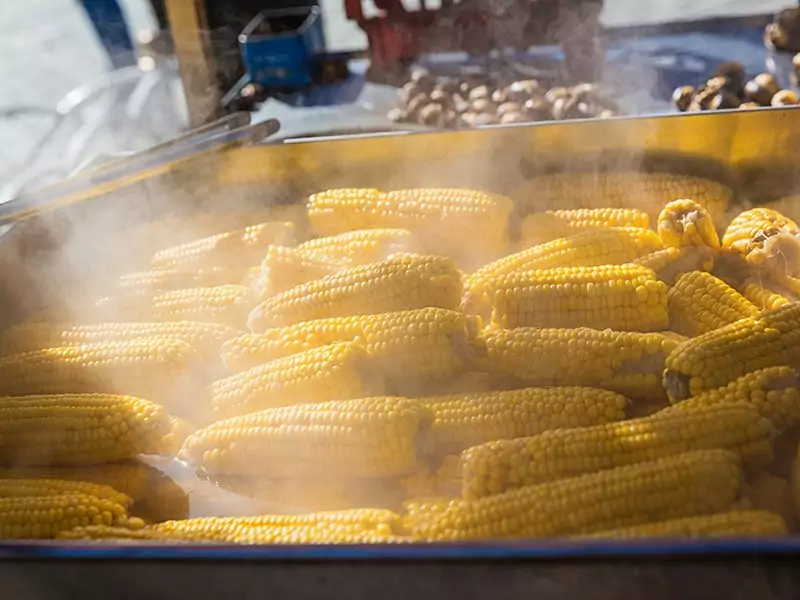
Since corn (or Mai) is a staple crop in the Philippines, the locals have tons of ways to cook them into something delicious, healthy, and filling.
This dish often appears grilled with a cream sauce in Mexican street cuisine. However, the Filipinos prefer boiled corns.
There are many boiled corn on the cob vendors on this country’s streets, so be sure to grab some if you have the chance to travel here. This simple snack might not be the most well-known Filipino street food, but it has many local fans.
Recommended place to eat:
Street vendors throughout Filipino markets
24. Binatog – Boiled White Corn Kernels
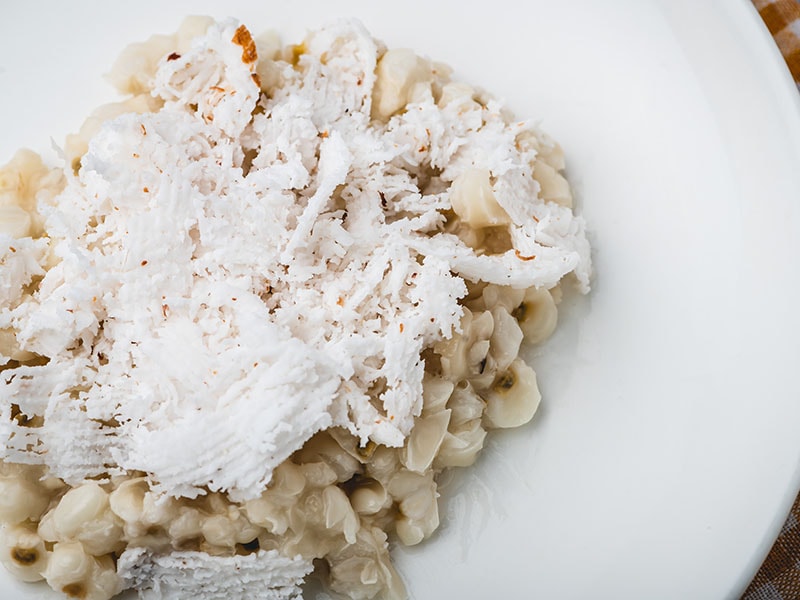
If you don’t like to eat corn straight on the cob, perhaps Binatog might suit your preference. Binatog is one of the most simple yet tasty Filipino street food snacks you can experience while in the Philippines.
To make this treat, the vendors will slice boiled corn on the cob, season it with salt and sprinkle some fresh shredded coconut on top. They often serve Binatog in a cup, so you can eat it easily while walking.
These versatile corn kernels can be made into a dessert with some grated coconut, sweetened condensed milk, or sugar.
Recommended place to eat:
Address: Pedro Gil St, Ermita, Manila, 1000 Metro Manila, Philippines
Time: 10AM–9PM (10AM–10PM on Friday and Saturday)
Facebook: www.facebook.com/
Instagram: @mang_binatog
Most Talked-About Filipino Cold Treats That You Should Explore
It’s time for something refreshing! Don’t miss out on the dishes I listed below if you need something to help you cool off the summer heat. From tasty ice cream to icy dessert, this section has it all!
25. Sorbetes – Dirty Ice Cream

Sorbetes is that one treat that every Filipino kid had growing up. So it is safe to say that this tempting Filipino dessert carries a significant part of their childhood in the Philippines. This treat is also very famous in other Southeast Asian countries.
You can buy this sweet treat in colorful wooden pushcarts around every corner of the streets. Some consider these pushcarts a symbol of Filipino culture. The wheels of the carts are even painted to resemble the sun in the flag of the Philippines.
Filipinos call this “dirty ice cream” to set it apart from the store-bought or “clean” ice creams. But the ice cream itself is not dirty, trust me on that! The ice cream is made from either powdered milk or coconut milk with artificial flavorings like chocolate, cheese, ube, mango, and Lanka.
Let’s learn more about Sorbetes and how it is served!
Recommended place to eat:
Address: 31 P. Burgos, Poblacion, Batangas, 4200 Batangas, Philippines
Time: 10AM–9PM
Phone: +639177071481
Facebook: www.facebook.com/
Address: 1245 Prudencio St, Sampaloc, Manila, 1008 Metro Manila, Philippines
Time: 7AM–11PM
Phone: +639171535688
Website: sites.google.com/
Facebook: www.facebook.com/
Instagram: @mangtomaspinoysorbetes
26. Ice Cream Sandwich

Sorbetes usually come in cones; however, some vendors sandwich these vibrantly colored scoops of ice cream between two slices of bread buns and create this unique dish. This Filipino ice cream sandwich is a fun culinary creation enjoyed by the people in this lovely country.
Stuffing a baguette with ice cream might seem unusual to those living in Western countries. But trust me, this sweet snack is delicious. After all, what can go wrong with combining ice cream and bread?
Recommended place to eat:
Street vendors throughout Filipino markets
27. Halo-Halo – Filipino Shaved Ice Sundae
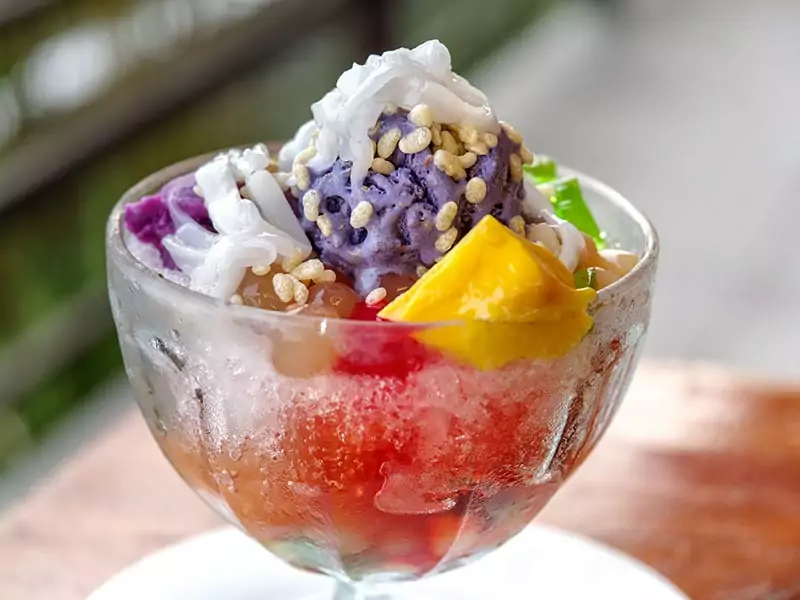
Without a doubt, Halo-Halo is the most well-known Filipino dessert to foreigners. It is a visually appealing shaved ice sundae made with tons of colorful toppings, including beans, purple yam, ice cream, tapioca pearls, and candied fruit, all piled over a bowl of shaved ice.
The treat started as a way for Filipinos to combat the burning heat in the all-year-long summer. It started gaining popularity over time and was brought with the people to other countries in their way of migrating.
Halo-halo can be traced back to pre-war Japanese Filipinos. Monggo Con Hielo, a dessert made of mung beans served with milk, sugar and crushed ice, was one of the early variants of Halo-Halo.
More native components were added over time to create the modern Halo-Halo. You can still find the original Monggo Con Hielo today along with variations that include chopped saba bananas and sweet corn.
Recommended places to eat:
Address: G/F SM City North EDSA, North Ave, Lungsod Quezon, Kalakhang Maynila, Philippines
Time: 10AM–9PM
Phone: +63283328097
Facebook: www.facebook.com/
Price: 120PHP (~2.3USD) per portion
Address: TDK Bldg, Congressional Ave, Bago Bantay, Quezon City, 1105 Metro Manila, Philippines
Time: 10AM–9PM
Phone: +6326225381
Facebook: www.facebook.com/
Price: 110PHP (~2.1USD) per portion
Address: Matina Town Square Compound, Gen. Douglas MacArthur Hwy, Matina, Davao City, 8000 Davao del Sur, Philippines
Time: 1PM–8:30PM
Phone: +63822851203
Facebook: www.facebook.com/
Instagram: @alingfopingshalohalo
Price: 105PHP (~2USD) per portion
28. Iskrambol – Ice Scramble

As a country positioned right on the equator of the Earth, the Philippines weather is not for the faint of heart. To combat the killer heat, Filipinos have come up with creative dishes to help them cool down. Iskrambol or Ice Scramble is one of those dishes.
Iconic for its pink color, Iskrambol consists of shaved ice, evaporated milk, flavorings, and food coloring. This sweet treat is trendy among Filipino children, especially after a hot day at school.
Food vendors usually pull up near elementary schools and parks, serving this delicious treat. Besides shaded ice, this refreshing dessert comes with toppings like chocolate syrup and powdered milk.
Recommended place to eat:
Address: Ph2 B4 L19, Bentley Street Garden Villas 1, Santa Rosa, 4026 Laguna, Philippines
Time: 11AM–10PM
Phone: +639451977209
Facebook: www.facebook.com/
Instagram: 90s_iskrambol
Price: 50PHP (~1USD) per portion
Other Delicious Dishes On Filipino Streets To Try Out
Let’s end your journey with some delectable street snacks. It will be a huge loss if you leave the Philippines without trying these iconic sweet treats! So take out your notebooks and quickly jot down these names.
29. Taho – Filipino Silken Tofu with Sago

Taho is one of the most famous breakfast dishes in this country, especially for those in a hurry. This simple treat is made with silken tofu, arnibal syrup, and sago pearls. If you’re looking for a dish that can energize you without being too heavy on the stomach, this is it!
This yummy Asian sweet treat is popularized by the large Chinese-Filipino community in the country. This is why it is very similar to other silken tofu treats in Chinese, Vietnamese, or Singaporean cuisine, which all derive from the Dou Hua in China.
Taho can be eaten with a spoon, sipped using a straw, or just slurped directly from the cup. The one that comes with a spoon is usually firmer.
When you come to the Philippines, you will see Taho vendors (or Magtataho) peddle their product on the sidewalk early in the morning, yelling “Taho!” to attract the attention of the customers.
Take a look at this and see how Filipino vendors serve their Taho!
Recommended places to eat:
Address: 1A, 14, 1008 Premero de Mayo St, Quezon City, Metro Manila, Philippines
Time: 9–11AM, 1–3PM (Close on Sunday)
Phone: +639190063504
Facebook: www.facebook.com/
Instagram: gianttaho
Price: 375PHP (~7.3USD) for 2.5L of Taho
Address: GF, North Wing, Outdoor,Kiosk, SM Mall of Asia, Seaside Blvd, Pasay, Metro Manila, Philippines
Time: 10AM–9PM
Phone: +639171799345
Facebook: www.facebook.com/
Instagram: tahobarph
Price: 50PHP (~1USD) per portion (different flavor)
Address: SM Mall Of Asia, J.W. Diokno Blvd, Pasay, 1300 Metro Manila, Philippines
Time: 10AM–10PM
Website: soyyummy.online
Price: 180PHP (~3.5USD) for 1L of Taho
30. Espasol – Filipino Rice Cake
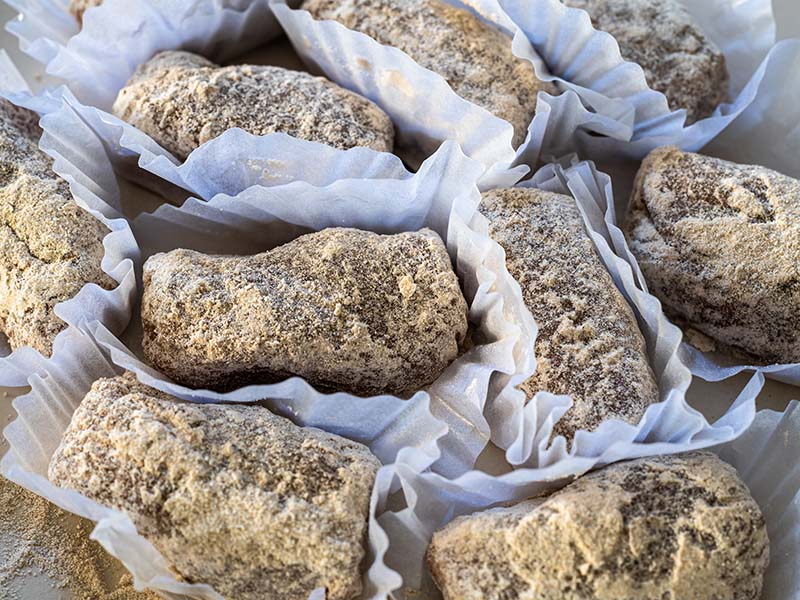
As rice plays such an important role in Filipino cuisine, it’s common to see it as an ingredient for dishes throughout the country. Filipinos even create interesting desserts out of glutinous rice.
Originated in Laguna province, Espasol is a chewy rice cake made of coconut milk, toasted glutinous rice flour, and grated green coconut. Once cooked, this mixture creates a soft dough shaped into a long cylinder and cut into smaller pieces.
Filipino bakers also use rice flour to coat the rice-based treat, preventing them from sticking to one another. Although Espasol is traditionally a Filipino Christmas treat, they are now available year-round in this country.
Recommended place to eat:
Address: 0224 J. Cometa Street, Nagcarlan, Laguna, Philippines
Time: 9AM–5PM
Phone: +63495307099
Facebook: www.facebook.com/
31. Bibingka – Filipino Coconut-Rice Cake
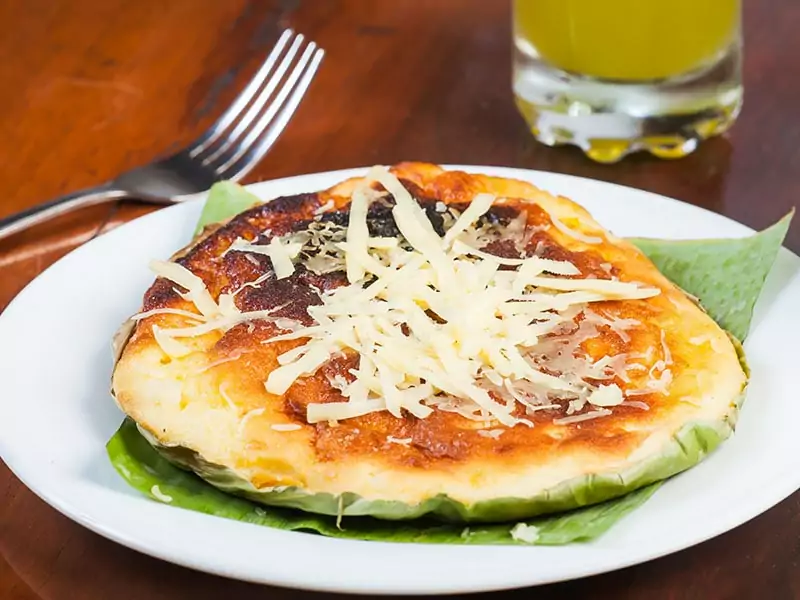
Bibingka is another sweet treat made from rice flour, but it has a nice twist that really sets it apart from other desserts.
During the time of colonization, this cake recipe made its way into Filipino cuisine and was localized to utilize existing ingredients in the Philippines.
The first written recipe of this dish can be found back in the 1750s. The original ingredients list calls for milk, eggs, coconut milk, sugar, butter, and rice flour.
In modern days, people sometimes add grated cheese, salted duck eggs, grated coconut, or other ingredients to the mix. The locals often cook Bibingka in clay pots lined with banana leaves, which creates a lovely smoky flavor that can hardly be found in any other cakes.
Recommended places to eat:
Address: Tayuman Street &, 1008 Rizal Ave, Santa Cruz, Manila, Metro Manila, Philippines
Time: Open 24 hours
Phone: +639984201653
Facebook: www.facebook.com/
Price: 55PHP (~1.1USD) for a special
Address: Nena’s Bldg., General Romulo Ave, Soccoro, Quezon City, 1109 Metro Manila, Philippines
Time: 10AM–4PM
Phone: +63289960478
Facebook: www.facebook.com/
Price: 65PHP (~1.3USD) for a special
Address: 4 Granada, Quezon City, 1112 Metro Manila, Philippines
Time: 9AM–8PM (9AM–7PM on Monday)
Phone: 024412118
Website: www.ferinosbibingka.com.ph
Facebook: www.facebook.com/
Price: 130PHP (~2.5USD) for a super Bibingka
32. Kutsinta – Steamed Rice Cake
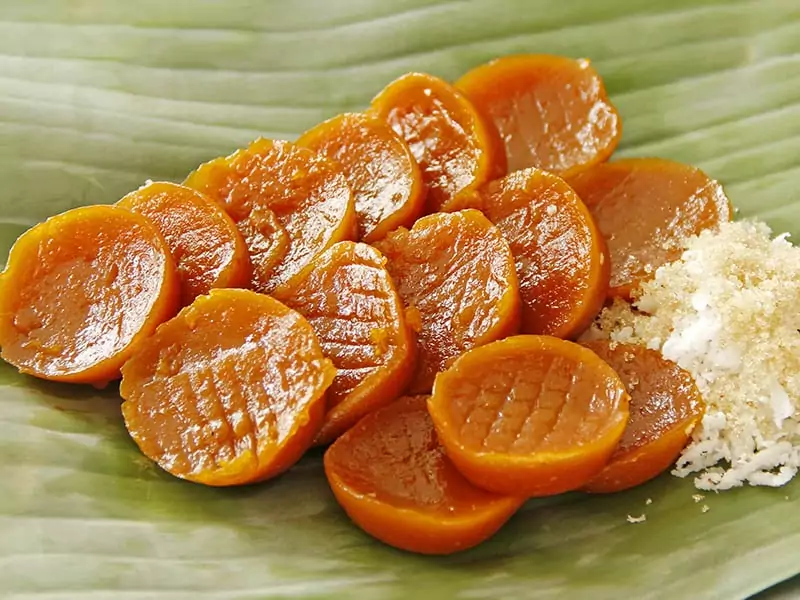
This is yet another dish made from rice flour, but it is just as crucial to Filipino cuisine as other rice-based sweets like Espasol or Bibingka.
Kutsinta or Puto Cuchinta is a famous Filipino steamed rice cake. It is made by streaming a mixture of rice flour, brown sugar, lye, and annatto extract in small ramekins to form a chewy, jelly-like dessert.
Often served alongside grated coconut, this well-known Filipino snack shares many similarities with Mont Kywe The in Burman and Kuih Kosui in Indonesia and Malaysia.
Filipino vendors usually sell this snack year-round along with Puto (a different type of Filipino steamed rice cake). Sometimes, this dessert will be topped with Filipino Dulce de Leche.
Recommended places to eat:
Address: 17 Kalayaan Ave, Makati, Metro Manila, Philippines
Time: 9AM–9PM
Price: 85PHP (~1.7USD) for 20 pieces
Facebook: www.facebook.com/
Instagram: nanayaidas
Rocha’s Delicious Puto & Kutsinta
Address: 12 E. Mendoza Street, Marikina, 1800 Metro Manila, Philippines
Time: 6AM–5PM
Phone: +63289411519
Facebook: www.facebook.com/
Instagram: rochasputo
Price: 120PHP (~2.3USD) for 50 pieces
Congrats, You Are Now A Filipino Street Food Expert!
And there you have it, folks, the most delectable and worth-exploring street foods in the Philippines! I hope that my suggestions today somehow convinced you to pack your bag, travel to this beautiful country, and learn more about Filipino cuisine.
Have you ever had Filipino foods before? If yes, which one is your favorite? If not, which of the dishes above do you look forward to the most? Tell me all about that in the comment section below!
Also, sharing is caring, so be sure to send this link to your friends, partners, or travel buddies and help them learn about this fantastic food culture. Thank you so much for your contribution. Stay safe, and goodbye, everyone!
